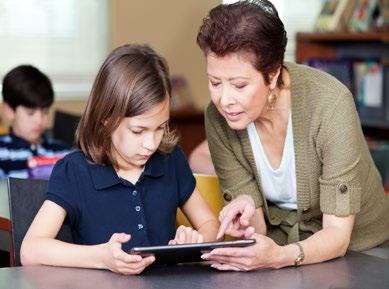
7 minute read
Emails activities
As an asynchronous form of communication, emails in literacy is perfect! This is because letter writing is asynchronous as the recipient may not be able to respond for some days or even longer. Real written communication can take place between student and student, teacher and student, class to class or school to school within the school time zone.
The asynchronous nature of emails allows it to be used as an effective collaboration tool for literacy learning.
Advertisement
Why should you teach this?
• It address ACELY1682 where students plan, draft and publish texts demonstrating increasing control over text structures and language features and selecting print, and multimodal elements appropriate to the audience and purpose; • Helps students to become familiar with ICT tools that will enable them to share and exchange information safely; • It compliments and extends their writing skills.
It has already been discussed how literacy learning can be taught by use of email in the classroom. The following activities will help you get started on some email projects being guided by the guidelines provided.
Imaginative Emails Project (Bennett, 2006)
ACTIVITY BRIEF DESCRIPTION
1. Project 1: Write email to a character in a story (Bennett, 2006).
2. Project 1.2: Communicate with children in another class over collaborative writing
3. Project 1.3: Improve the skeleton stories
4. Project 1.4: Write a review of a shared story
5. Project 1.5: Respond to a review of their story Set up an email account for a key character in the story you will be using. For an immediate response, have a colleague on another computer who has been briefed about the character. In small groups, ask students to produce three questions they would like to ask the character. They can identify their favourite question which they will send using email to the character. Before the lesson, explain the activity to a colleague in a parallel class and synchronise the timing of the lesson. Explain the activity to the students and demonstrate by corresponding with your colleague taking turns to write a sentence in a story. This is sent off by email and your colleague sends the next sentence. Show the students the example story which you and your colleague started. Ask the students to suggest ways in which the first two sentences might be improved. The students can add or change words or suggest a new intervening sentence. Continue with pairs of sentences until you feel the students have understood the task. Liaise with your colleague to ensure that all the stories have been completed and dispatched. This may take several lessons. It is a good idea to check the email accounts to ensure all groups have received an email. Discuss the criteria they will use to assess the stories and agree on the way feedback will be provided. Remind students of the previous activity. Explain the purpose and structure of this activity. In groups, discuss their response. For example, they may decide to change part of the story. The other students comment about the appropriateness of the group’s response and if necessary, suggest amendments.
1. Compose two columns. In one column, write several phrases from different types of emails, and in the other column write the email types. Students will match the phrases with the types. 2. Prepare several phrases commonly used in formal emails, and sentences that express similar ideas. Students will rewrite the sentences by using the target phrases. 3. Prepare several formal and informal phrases for each of the following communicative purposes. Students will identify which phrases are formal and which are informal. 4. Prepare two emails with a similar purpose (e.g., an invitation to a party): one formal and one informal.
Students will compare both emails by discussing: potential audience, email structure, language, tone, and stance. 5. Prepare an email that violates rhetorical conventions (e.g., a formal email written in a sloppy manner or in a rude tone). Ask students to analyse the email, identify the violations, and rewrite the email in a correct manner. 6. Prepare an informal email with a particular communicative purpose (e.g., apologizing for a missed meeting). Give students a list of formal phrases that could be used in a formal email with the same purpose.
Students will rewrite the original informal email to make it formal by using the target phrases.
• Gapped email propositions practice; • Email phrases propositions work.
From https://www.tefl.net/elt/ideas/e-mail/fun-email-practice/
• Line by line chain letters: Each student is to write the beginning of an email on a piece of paper, folds it down so that the line isn’t showing and then passes it on clockwise to another student. That student then writes a second line and does the same. This continues until the email is completed. The student at this time passes it one more time to another student. They read it and tell the class if it makes sense as an email and why (why not). • Email and response chain letters: Similar to the above, however, students write a complete email on the paper. • Rearrange the text; Cut up some emails between lines or paragraphs on paper and ask students to try to put them back together. • Rearranging the texts: Similar to the above, however, instead here the students have to put a sequence of emails back in the order they were written by looking at how the formality decreases, who replies to who etc. • Reading race: Ask the students to find the answer to the question as soon as possible and then each team is to email the correct answer. • Use emails as role play cards: Give the role play cards to students as emails. For example, an email asking them to interview their partner to find out what the personal problem that is interfering with their work but they won’t tell anyone is. Then after they have finished the speaking activity, you can look at the language in the emails and ask to write a reply.
Lesson Description
Show the students a short video of film especially made for the lesson. For example, it could be of a recent movie such as The Incredibles 2! In it, you could ask a colleague to dress up as a character who would present a problem to the students and ask them for their help.
The students work in groups to come up with a possible solution to the problem. This could either be done in whole-class discussions or group-guided writing sessions all of which you will need to help them to structure the plot of the story by focusing on two major factors: introducing a dilemma and presenting a solution.
At the end of each day, the students will send group emails to the character about ideas on how the mystery can be solved. Using this information, he sends them video updates the following morning, responding to their ideas and informing them of progress on the case.
The shared writing sessions produce a complete story by the end of the week, with involvement from the whole class.
Grouping of Students
The students will be grouped according to ability for the writing activities and for the group email sessions. Each writing session has two focus groups either by the teacher as one and the teacher aide for the other.
Differentiation
This lesson will be partly differentiated by task and outcome. Ensure that you provide more structure and scaffolding for less confident student writers and make changes to the questions to meet the needs and abilities of the group.
Problem Statement Write your own problem statement to present to students remembering key use of ICT terminology and features.
Achievement Standards (English)
• Students create a range of texts for familiar and unfamiliar audiences; • They contribute actively to class and group discussions, asking questions, providing useful feedback; • Demonstrate understanding of grammar and choose vocabulary and punctuation appropriate to the purpose and context of their writing and; • They listen to others’ views and respond appropriately using interaction skills. • Use knowledge of sounds and high frequency words to spell words accurately, checking their work for
Assessment
Several assessment opportunities present themselves in this activity In terms of speaking and listening, careful questioning at the whole-class stage should ensure that children are contributing at their own level, and observation of group discussions would allow the adult to consider not only the level of contribution of the participants, but also the extent to which they were able to produce ideas for possible solutions.
Complete the table below:
Higher Order Skills ICT Techniques Curriculum link
Email Activity
1. Students watch a short film based on a recent movie with a key character on the IWB. 2. Students then work in groups to brainstorm possible solutions. This can be in whole-class discussions or group-guided writing sessions. Sessions will help them structure the plot of the story into two major factors: the problem and the solution. 3. Each group emails the character their ideas as to how the mystery can be solved. 4. Using this information, the character (one of your colleagues) sends them video updates the following morning, responding to their ideas and informing them of the progress.




